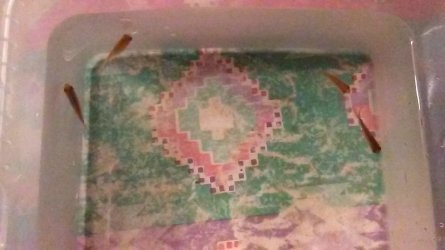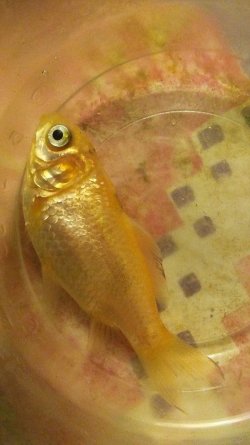Jim Sinclair
Fish Fanatic
I recently posted about a sick baby fish in the thread at http://www.fishforums.net/threads/floppy-baby-goldfish-maybe-constipated.449974/
Briefly, the baby fish (either common goldfish or common/comet hybrids) hatched July 21. A couple of weeks ago I saw one lying on the floor of the tank; initially thought it was dead; discovered it was alive when I tried to net it; kept it in a hospital tank for a week during which I did daily water changes and never saw any poop; tried salt, Paraguard, peas, and an Epsom salt bath; took it to the vet on October 25; fish died while we were waiting to check out.
Since then I have been keeping an eye out for any other fish that seem to be swimming abnormally or lying on the tank floor. Everything has looked fine right up through feeding time this evening.
Then tonight when I lifted the tank lid to do a water change, I saw a fish floating on its side on top of the water. This one is definitely dead. No movement of anything at all when I scooped it out of the water.
It's about twice as big as Floppy was. I think it looks normal (disclaimer: I have never seen baby goldfish until these last few months), but it has some fine black edges along the fin.
I had left my phone upstairs to charge so I didn't get a picture. The fish is now in a jar of water in the refrigerator. I can get pictures tomorrow.
Of course my first thought was ammonia burn, even though I do twice-daily partial water changes in that tank. So I immediately did a water test, *before* proceeding with a water change.
Results, from the API Freshwater Master Test Kit:
Ammonia 0
Nitrite 0
Nitrate 10
pH 7.6 with the regular drops, 7.4 with the high range drops. (This is the norm with my tanks and my tap water. I just call it 7.5.)
So, not ammonia poisoning with those results.
What else could kill a young goldfish that didn't seem to be in any distress when I checked on them a few hours ago, and cause black edges on the dorsal fin?
Briefly, the baby fish (either common goldfish or common/comet hybrids) hatched July 21. A couple of weeks ago I saw one lying on the floor of the tank; initially thought it was dead; discovered it was alive when I tried to net it; kept it in a hospital tank for a week during which I did daily water changes and never saw any poop; tried salt, Paraguard, peas, and an Epsom salt bath; took it to the vet on October 25; fish died while we were waiting to check out.
Since then I have been keeping an eye out for any other fish that seem to be swimming abnormally or lying on the tank floor. Everything has looked fine right up through feeding time this evening.
Then tonight when I lifted the tank lid to do a water change, I saw a fish floating on its side on top of the water. This one is definitely dead. No movement of anything at all when I scooped it out of the water.
It's about twice as big as Floppy was. I think it looks normal (disclaimer: I have never seen baby goldfish until these last few months), but it has some fine black edges along the fin.
I had left my phone upstairs to charge so I didn't get a picture. The fish is now in a jar of water in the refrigerator. I can get pictures tomorrow.
Of course my first thought was ammonia burn, even though I do twice-daily partial water changes in that tank. So I immediately did a water test, *before* proceeding with a water change.
Results, from the API Freshwater Master Test Kit:
Ammonia 0
Nitrite 0
Nitrate 10
pH 7.6 with the regular drops, 7.4 with the high range drops. (This is the norm with my tanks and my tap water. I just call it 7.5.)
So, not ammonia poisoning with those results.
What else could kill a young goldfish that didn't seem to be in any distress when I checked on them a few hours ago, and cause black edges on the dorsal fin?





